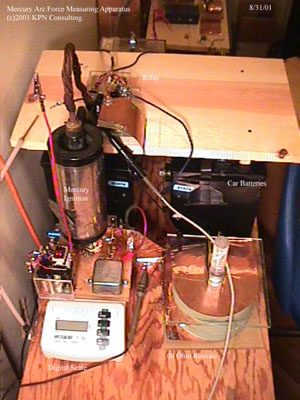Research
home page | Next page
Unbalanced
forces in a mercury arc?
There
was some dicussion on the Vortex-L listserv about experiments
that were done concerning Anomalous Cathode Force in electric
discharges. It was theorized by Frederick Sparber that
a net force might develop on the entire anode/cathode
structure in a mercury arc discharge, said force being
proportional to the mass difference between the ionic
carrier Hg+ and e-. This ratio is about 600, so the putative
force should be easily measurable.
Having
a mercury ignitron on hand, I thought I would have a go
at it and see if the effect would reveal itself. The photo
below is of the actual test apparatus. All control devices
and the oscilloscope are in the next room. The mercury
sits in a puddle at the base of the ignitron, which is
the cathode. Flexible conductors allow the igntiron to
move freely in the vertical direction. An anomalous force
with either add or subtract from the weight measured by
the digital scale. The scale is accurate to a gram, and
the total mass of the ignitron is about 1/2 of the total
range of the scale. The red wire with clip is used to
bypass the ignitron, in order to test if conductor flexure
or residual magnetism causes any artifact force to manifest.
The experiment involves allowing a measured pulse of current
to pass through the ignitron, whilst the scale is visually
observed for possible variation.
The
circuit itself is fairly straightforward. Two car batteries
are used in series to provide 24 volts at upwards of 800
amps on pulse. The .08 ohm resistor provides a ballast
to allow smooth and limited current flow in the mercury
arc. A problem arises in that once the current begins
to flow in the arc, only a reverse current or interruption
will cause the arc to extinguish. Therefore an auto ignition
relay was used in series with the ignitron. Control circuitry
turns this relay on and about 1/10 of a second later fires
the ignitron. The relay then opens, blocking current and
finishing the run.
The
two voltage probes are used to measure the voltage drop
across the entire circuit (ignitron and resistor) and
the current sensing/ballast resistor, providing accurate
voltage and current replica signals. The triggering circuits
for the relay and the ignitron are floating, so circuit
ground is the negative pole of the car batteries. All
probe grounds come to this common point.

Research
home page | Next page
